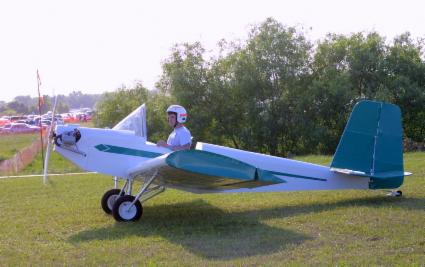CA-2
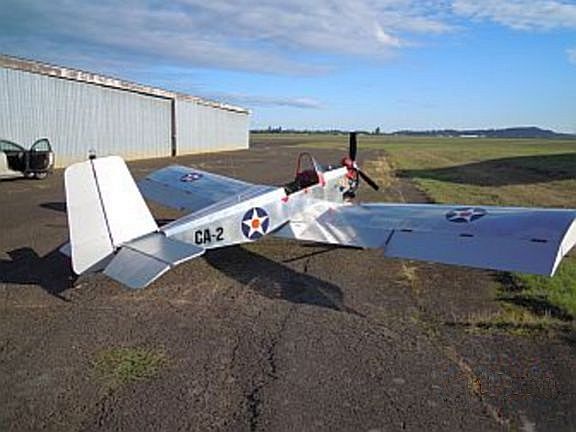
The picture above was taken of the first customer-built CA-2. This beautiful ultralight was built by George Genevro of Salem, OR and it's first flight was on February 5, 1998. This CA-2 was affectionately nicknamed “Rosey” by Dwight Hoover who was a secondary owner. Dwight named it that because of all the rivets which are installed and because George painted so many of the gussets red. Dwight added the roundels because he thought the roundels fit the design of an open cockpit aircraft. And, for the record, he has actually owned this CA-2 twice! The person he sold it to replaced the Rotax 377 that George had installed with a new Hirth F-33. According to Dwight, "When I took off, threw the coals to it, 100%, it just leaped off the ground, it seemed like it went up in a hurry." Take a look at his video here: https://youtu.be/u1sVAOGPG3I. The picture is copyright 2014 and the video is copyright 2021 by Dwight Hoover, used with permission.
Thank you for your interest in the CA-2. We are very proud to present the Frank Griffith designed CA-2 (Corning Aircraft, aircraft #2) ultralight/experimental aircraft design to the homebuilt aircraft community. We are very pleased to add this great design to our stable of aircraft. It is exciting and such an honor for us to carry on Frank's legacy and to support the builders and owners of this wonderful and affordable homebuilt ultralight aircraft. We look forward with great anticipation to keeping this aircraft plans set available and supported for the aircraft homebuilders to come.
3-view from the actual plans - (Click here to view larger picture).
Stick assembly for CA-2 with lowered seat
Canopy modification
1/2 VW Engine Motor Mount
Tailwheel Modification
Optional AL Gas Tank
As you can see, we have the optional canopy drawing which Morrey designed to make a Hummel Bird canopy fit the CA-2. Hummel Aviation had a canopy kit for the CA-2 but have since ceased production. We have considered producing the CA-2 canopy kit but have not had enough interest in an enclosed version. We also include the 1/2 VW engine installation drawing with each set of plans for those who may desire that 4-stroke sound. To help the potential CA-2 builder, we have created a CA-2 information manual that you can download by clicking in this link: CA-2 Information Manual
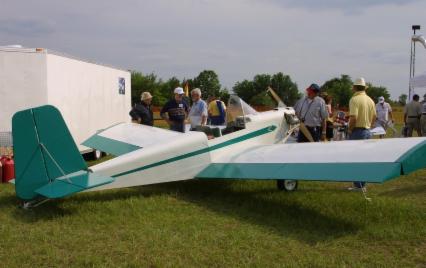
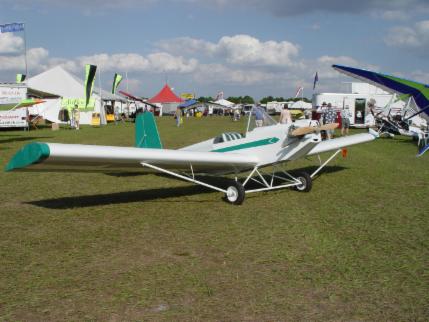
General Characteristics:Performance:
Crew One Capacity No passengers Length 16 ft. 6 inches (5.03 m) Wingspan 26 ft. (7.93 m) Wing area 117 ft² (10.9 m²) Empty weight 250 lbs. (113 kg) Useful load 270 lbs. (122 kg) Max takeoff weight 520 lbs. (235 kg) Power Plant Rotax 277, 28 hp. (21 kW)
Never exceed speed 80 mph (130 km/h) Maximum speed 63 mph (102 km/h) Cruise speed 50 mph (81 km/h) Stall speed 26 mph (42 km/h) Range 125 SM (203 km) Service ceiling 10,000 ft. (3050 m) Rate of climb 600 fpm (3.05 m/s) Wing loading 4.4 lbs./ft² (21.6 kg/m²) Power/Mass 18.6 lbs./hp. (0.09 kW/kg)
With this set of plans and following them closely, the construction time should only require about 600 hours to build the CA-2. An experienced aircraft builder should be able to build a CA-2 in less time. The airframe is of all-metal construction using 2024-T3 aluminum sheet, extruded angles and tubing, fastened primarily with stainless steel pop rivets. The fuselage and wings are of monocoque stressed skin construction. The wings include plain flaps and differential ailerons. Each wing panel is easily removed from the aircraft by removing only three bolts. The control surfaces are made from aluminum tubing; they are fabric covered and actuated by pushrods. The landing gear is of conventional configuration with a steerable tailwheel linked to the rudder. The airframe structure is stressed to +4.4 and -2.2 g's. Special tools are not required to be purchased, construction only requires the use of normal hand tools, plus a small bending brake and a tube bender.
The prototype is powered by a Rotax 277. Heavier engines can be installed on the CA-2, however, the aircraft will no longer meet US FAR 103 weight requirements for ultralight vehicles. Other engines used include the Rotax 377, Rotax 447, 1/2 VW, Hirth F-33, Kawasaki 340 and Kawasaki 440-2A.
The CA-2 plans may be purchased for $160.00 USD per set plus shipping cost.
The plan sets will be shipped out insured and placed in a padded shipping envelope for protection. You may use a personal check (must clear both banks), US Postal Money Order, Certified Check, or Cashier's Check for payment purposes. Note: Georgia residents must add 7% sales tax.
Shipping:U.S.P.S. mail to Continental US: $20.00
U.S.P.S. mail to Alaska: $25.00
U.S.P.S. mail to Hawaii: $30.00
U.S.P.S. mail to foreign countries: Contact us for shipping costs.
U.S.P.S. mail to Continental US: $20.00
U.S.P.S. mail to Alaska: $25.00
U.S.P.S. mail to Hawaii: $30.00
U.S.P.S. mail to foreign countries: Contact us for shipping costs.
If you wish to purchase online, please use PayPal as your option, this will allow you to use:





Click on the PayPal image below to go to the PayPal website. Use "contact @ adamsaero dot com" for the recipient ("To") e-mail address. Remember to add the appropriate shipping amount plus tax if applicable to the plans total. Please call or text 404.219.7326 when you use PayPal, we have had issues with their notification process.
************************************************************************************************************
About Frank Griffith the Designer and Builder of the Original CA-2


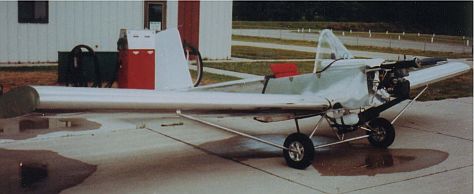
The pictures above were taken of the CA-2 prototype built by Frank Griffith of Corning Aircraft in 1992.
There, we said it!
Here is an interesting factual non-CA-2 related history that can be added here due to the reference made to the Experimental Aircraft Association. Paul Poberezny (https://en.wikipedia.org/wiki/Paul_Poberezny) actually loved what we were/are doing and requested that we help him reestablish the Sport Aviation Association (SAA) back in 2009 & 2010. We had many phone calls, e-mails and discussions with Paul during that time period concerning reviving SAA. Unfortunately, I was TDY at Edwards Air Force Base when I was supposed to be with Paul to present the revitalization plan at the 2010 Frasca Fly-in at Urbana, IL. A couple of weeks after the fly-in was over, Paul called me with the "Bad news." He told me that there just wasn't enough interest shown at the fly-in to justify bringing SAA back. I was crushed, I had already told Paul that I would do whatever needed to be done, including leaving my fulltime position to help the cause. However, he seemed to be very distraught about losing SAA and so our dream had ended. I didn't hear from Paul for several years after this, but he and Ed Fisher were able to reestablish SAA. Ed and his wife ran SAA for a short time until it succumbed to closing for a second time. I'm still a proud SAA member.
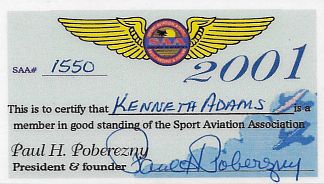
This information is subject to change without notice.
